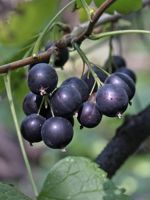Mon-Fri 9am - 5pm Mountain time
Red Elderberry vs Northern Black Currant
Ribes hudsonianum
Sambucus racemosa
CUSTOM GROW
NOT AVAILABLE THIS SEASON - MIGHT RETURN
Northern Black Currant is a native deciduous shrub found across Canada and the northern United States. Dark purple to black berries that ripen in summer and provide food for wildlife and humans. Fragrant yellow-green flowers that attract a wide variety of pollinators.
This shrub is well adapted to moist soils and can even survive periods of flooding. It has an interesting bronze colour in fall.
Red Elderberry is an attractive, medium-sized deciduous shrub.
It produces clusters of white flowers in the spring and bright red berry-like drupes, which provide beautiful contrast against its coarse, textured green foliage.
Red Elder can be pruned as a small single or multi-stemmed tree.
Northern Black Currant Quick Facts
Red Elderberry Quick Facts
Toxicity: toxic to humans

